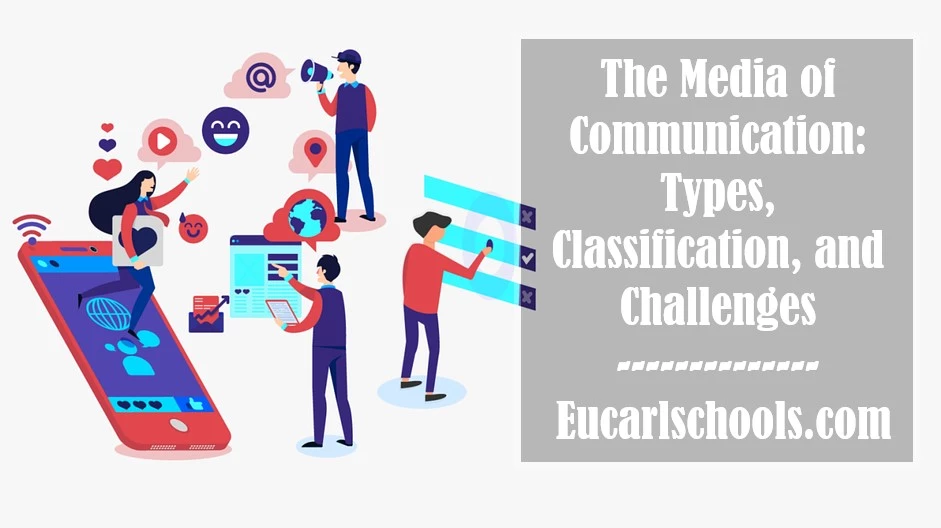The Media of Communication: Types, Classification, and Challenges
Communication is certainly not a new phenomenon. It has existed as far back as the beginning of humans. As long as human beings lived together, the need for communication was never in doubt. Looking back from then to now, one can only wonder how rapidly the means of communication in human societies have evolved.
It must be said that these various means of communication have kept in touch with the changing times pretty well. In this piece, we would take a journey through the types, classification, and even challenges that come with communication media.
The Media of Communication: Types, Classification, and Challenges.

Types of Media of Communication
In recent times, the media of communication are typified under four basic categories. They include:
The Print media.
The Broadcast media.
The Interpersonal media.
The Interactive or New media.
It would be therefore pertinent to discuss these four broad categories.
The Print Media
Print Media as the name implies are those types of Media of Communication that involve texts printed on paper sheets. They consist of books, journals, magazines, and newspapers. Newspapers generally come out on a daily or weekly basis. Journals could be monthly, quarterly, or even yearly.
Magazines could also be on a monthly, quarterly, or yearly issue. In a country like Nigeria majority of the print media comes in English which is her lingua franca. Many have however raised eyebrows at the fact the prints have been above the average reader’s ability to comprehend.
Nevertheless, that can be countered with the advent of many print media coming in the understandable and relatable local languages.
The Broadcast Media
Many of the broadcast media, it must be painfully pointed out are government-owned and managed. And even the ones which are considered to be owned by private individuals are not entirely their property.
The danger in this is that a failing government can leverage this broadcast media and sell very bad propaganda that keeps a society underdeveloped. Nonetheless, the benefits like employment opportunities and even the provision of interactive elements that afford users to express themselves can not be neglected.
The very common examples include the radio and the television. These two broadcast media have the ability to create good imagery of what is being communicated.
At this juncture, we must recognize the fact that there exists a world of difference between print and broadcast media. The print media is time-independent in sharp contrast to the broadcast media is time-dependent.
The newscaster on your TV screen or radio space has a limited time to convey whatever the information is. Another important difference to note is the fact that the radio presenter or TV newscaster has to take into consideration the attention span of the audience.
With broadcast media like TV or radios, first-hand or real-time events are reported compared to the print media which have a lesser chance of reporting trends as they come in.
Interpersonal Media
This is a peculiar kind of communication that involves people who are not in close proximity to each other. These two people as the case many times is have a good knowledge of each other that can suffice for a good communication time. The degree of closeness in the relationship can range from as close as married or dating couples to an employee and employer relationship.
Despite the fact that the regular number of two are involved in interpersonal relationships, it can even extend to family member relationships where they get to interact with each other especially when they are physically distant from each other.
The New Media
As we earlier said, the current state of human interactions has evolved and so has the means of communication. The present situation with human relationships demands there is instantaneous feedback between communicating parties whilst still retaining increased participation amongst the sending and receiving parties.
Another very crucial feature of this new media is the enlarged freedom between parties on what the contents of their communication are. However, this turned out to be very counterproductive as it has afforded just any Tom, Dick, or Harry to put out whatever they deem fit even as far as obscene and sordid clips which ultimately defeats the initial intent of the communication.
Classification of the Media of Communication
Search engines and sites
Blogs
Chats and Interactive forums
Video content
The Internet
Mobile and portable devices
Categories of Social Media Networks
Search engines such as Google, Yahoo, and Bing.
Social Media like Facebook, WhatsApp, and Twitter.
The Internet or World Wide Web
General Features of Communication Media
Interactivity
Every media of communication should be able to afford users the ability to interact with each other. There has to be a means for smooth exchange of what information needs to be passed.
Immediacy
It is never enough for these media to provide effective means, the information conveyed has to be done at the exact moment required. There is a time factor with information and good communication media must put this into good consideration.
Massiveness
Communication users do not want to be bound by space, most importantly. The increased capacity to accommodate the variety of information users wish to pass across is favored by users.
Cheap Cost
No one desires to spend excessively. Communication technologies are tasked with the responsibility of providing affordable means that the common man can utilize to send out relevant information.
Instantaneous Feedback and Response
Communication is needless if the recipient does not interpret the sent information at the required time. The Media of Communication that would be considered by the general populace are the ones that have a swift response and feedback features.
Read Also: Differences Between Dissertation and Thesis
Challenges of Media of Communication
The media of communication as a result of drastic changes in times as permanently lost certain old features which were characteristic them and proved helpful.
It must be said that the average citizen is empowered with the media of communication and has the ability to share information by unchecked and unregulated means.
Privacy is now a thing of the past because anyone can have access to any piece of information without even moving an inch.






